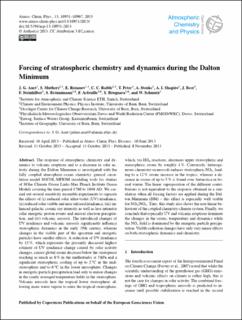Please use this identifier to cite or link to this item:
https://doi.org/10.21256/zhaw-4655| Publication type: | Article in scientific journal |
| Type of review: | Peer review (publication) |
| Title: | Forcing of stratospheric chemistry and dynamics during the Dalton Minimum |
| Authors: | Anet, J. G. Muthers, S. Rozanov, E. Raible, C. C. Peter, T. Stenke, A. Shapiro, A. I. Beer, J. Steinhilber, F. Brönnimann, S. Arfeuille, F. Brugnara, Y. Schmutz, W. |
| DOI: | 10.21256/zhaw-4655 10.5194/acp-13-10951-2013 |
| Published in: | Atmospheric Chemistry and Physics |
| Volume(Issue): | 13 |
| Page(s): | 10951 |
| Pages to: | 10967 |
| Issue Date: | 2013 |
| Publisher / Ed. Institution: | Copernicus |
| ISSN: | 1680-7316 1680-7324 |
| Language: | English |
| Subject (DDC): | 551: Geology and hydrology |
| Abstract: | The response of atmospheric chemistry and dynamics to volcanic eruptions and to a decrease in solar activity during the Dalton Minimum is investigated with the fully coupled atmosphere–ocean chemistry general circulation model SOCOL-MPIOM (modeling tools for studies of SOlar Climate Ozone Links-Max Planck Institute Ocean Model) covering the time period 1780 to 1840 AD. We carried out several sensitivity ensemble experiments to separate the effects of (i) reduced solar ultra-violet (UV) irradiance, (ii) reduced solar visible and near infrared irradiance, (iii) enhanced galactic cosmic ray intensity as well as less intensive solar energetic proton events and auroral electron precipitation, and (iv) volcanic aerosols. The introduced changes of UV irradiance and volcanic aerosols significantly influence stratospheric dynamics in the early 19th century, whereas changes in the visible part of the spectrum and energetic particles have smaller effects. A reduction of UV irradiance by 15%, which represents the presently discussed highest estimate of UV irradiance change caused by solar activity changes, causes global ozone decrease below the stratopause reaching as much as 8% in the midlatitudes at 5 hPa and a significant stratospheric cooling of up to 2°C in the mid-stratosphere and to 6°C in the lower mesosphere. Changes in energetic particle precipitation lead only to minor changes in the yearly averaged temperature fields in the stratosphere. Volcanic aerosols heat the tropical lower stratosphere, allowing more water vapour to enter the tropical stratosphere, which, via HOx reactions, decreases upper stratospheric and mesospheric ozone by roughly 4%. Conversely, heterogeneous chemistry on aerosols reduces stratospheric NOx, leading to a 12% ozone increase in the tropics, whereas a decrease in ozone of up to 5% is found over Antarctica in boreal winter. The linear superposition of the different contributions is not equivalent to the response obtained in a simulation when all forcing factors are applied during the Dalton Minimum (DM) – this effect is especially well visible for NOx/NOy. Thus, this study also shows the non-linear behaviour of the coupled chemistry-climate system. Finally, we conclude that especially UV and volcanic eruptions dominate the changes in the ozone, temperature and dynamics while the NOx field is dominated by the energetic particle precipitation. Visible radiation changes have only very minor effects on both stratospheric dynamics and chemistry. |
| URI: | https://digitalcollection.zhaw.ch/handle/11475/8912 |
| Fulltext version: | Published version |
| License (according to publishing contract): | CC BY 3.0: Attribution 3.0 Unported |
| Departement: | School of Engineering |
| Organisational Unit: | Centre for Aviation (ZAV) |
| Appears in collections: | Publikationen School of Engineering |
Files in This Item:
| File | Description | Size | Format | |
|---|---|---|---|---|
| 2013_Anet_Forcing_of_stratospheric_chemistry.pdf | 5.84 MB | Adobe PDF |  View/Open |
Show full item record
Anet, J. G., Muthers, S., Rozanov, E., Raible, C. C., Peter, T., Stenke, A., Shapiro, A. I., Beer, J., Steinhilber, F., Brönnimann, S., Arfeuille, F., Brugnara, Y., & Schmutz, W. (2013). Forcing of stratospheric chemistry and dynamics during the Dalton Minimum. Atmospheric Chemistry and Physics, 13, 10951–10967. https://doi.org/10.21256/zhaw-4655
Anet, J.G. et al. (2013) ‘Forcing of stratospheric chemistry and dynamics during the Dalton Minimum’, Atmospheric Chemistry and Physics, 13, pp. 10951–10967. Available at: https://doi.org/10.21256/zhaw-4655.
J. G. Anet et al., “Forcing of stratospheric chemistry and dynamics during the Dalton Minimum,” Atmospheric Chemistry and Physics, vol. 13, pp. 10951–10967, 2013, doi: 10.21256/zhaw-4655.
ANET, J. G., S. MUTHERS, E. ROZANOV, C. C. RAIBLE, T. PETER, A. STENKE, A. I. SHAPIRO, J. BEER, F. STEINHILBER, S. BRÖNNIMANN, F. ARFEUILLE, Y. BRUGNARA und W. SCHMUTZ, 2013. Forcing of stratospheric chemistry and dynamics during the Dalton Minimum. Atmospheric Chemistry and Physics. 2013. Bd. 13, S. 10951–10967. DOI 10.21256/zhaw-4655
Anet, J. G., S. Muthers, E. Rozanov, C. C. Raible, T. Peter, A. Stenke, A. I. Shapiro, et al. 2013. “Forcing of Stratospheric Chemistry and Dynamics during the Dalton Minimum.” Atmospheric Chemistry and Physics 13: 10951–67. https://doi.org/10.21256/zhaw-4655.
Anet, J. G., et al. “Forcing of Stratospheric Chemistry and Dynamics during the Dalton Minimum.” Atmospheric Chemistry and Physics, vol. 13, 2013, pp. 10951–67, https://doi.org/10.21256/zhaw-4655.
Items in DSpace are protected by copyright, with all rights reserved, unless otherwise indicated.